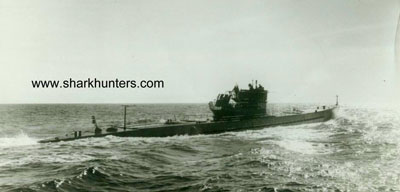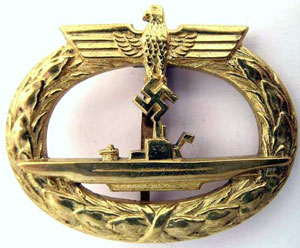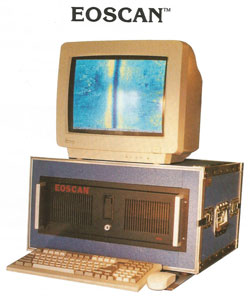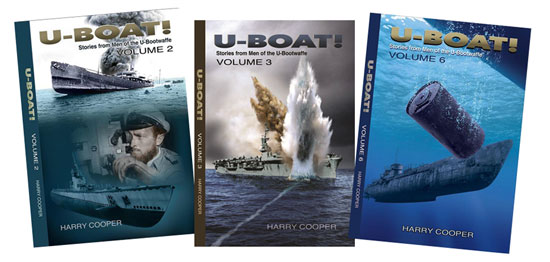Story of U-1226 Discovery Lingers in Cape Cod Community

The U-1226 was a standard type IX-C open ocean submarine. This is the U-505, of the same class, which is on display at the Museum of Science and Industry, Chicago, Illinois.
“We all donated our services,” Matthias said, and used our imaging system aboard Al’s 25-foot boat. A major piece of equipment, called Eoscan, created 3-D images of objects on or beneath the sea floor. Although the sub is almost

The German U-boat combat badge (U-bootfahrer–U-boat Men) awarded after 60 days on a war patrol or on two shorter war patrols. Credit: Harry Cooper, Sharkhunters
The team didn’t dive on their discovery, preferring to contact German officials for their input. German diplomats showed little interest in the find and preferred it to be declared a war grave and sealed tomb. But the door was open for diving since the state of Massachusetts had no jurisdiction under the Abandoned Shipwreck Act. The sub was purported to be four miles out, one mile beyond the maritime law.

This 1993 Eoscan was purported to create 3-D images of objects on or beneath the sea floor. Credit: Boston Globe
Michaud said that naval archives revealed the Navy and Coast Guard had been looking for a German sub deploying spies on U.S. soil. He was convinced it was a “spy sub.” But if the U-1226 had been a spy sub, why would the captain break radio silence—a real no-no in the German submarine command– and then compound his faux pas by refusing to get off after being warned? Marine historian Carol Schmid says, “This would be more like something enacted by the Keystone Kops rather than the sly fox tactics of the German U-boat arm.” Schmid was one of the first to become suspicious of Michaud and Matthias, particularly when they claimed the sub carried gold bullion, art treasures and personable valuables. Naval personnel specializing in submarine history also doubted the story and remained skeptical about Mathias’ technology and interpretation of his sonar pictures.

Three of Harry Cooper’s books. For a list of these and others, contact: Harry Cooper at Sharkhunters. Credit: Harry Cooper, Sharkhunters
Finally, in exposing the Polaris Group, what does Harry Cooper, the “Dean” of German submarine history, have to say? “You mean that the secret U-boat filled with gold in the Sea of Tranquility is bogus?” Harry says with a smile. “An attorney from New England has been one of the engines behind exposing them and pushing the FBI into going after these frauds. I was interviewed about them by the FBI and various TV stations and newspapers some years ago. One of the Polaris Group even confessed to the FBI about making up phony files and documents. But they’re still free. How these guys are not in prison is a mystery to me.”
Yes, all of it was a ruse. Many journalists, including yours truly, had the proverbial “egg on the face.” But we all owned up to our mistake, gave an apology and corrected our stories. The U-1226, a Class IX-C open ocean sub, was never found. The Navy lists it as “a probable loss somewhere north of the equator.”
Note: Harry Cooper of Hernando, Florida, has worn many hats in an adventurous and diverse career. He has been a corporate executive for a large company, a race car driver and instructor, a boat captain and a publisher. A student of history, especially that of the German submarine command, he started a newsletter in 1983 that was simply designed to share his interest with others. Little did Harry realize at the time that this would grow into a popular magazine as well as an International U-boat historical organization known as “Sharkhunters.” Cooper’s proudest moment came when Sharkhunters was recognized as the world’s largest and only official site for U-boat history. He has written many books about U-boats and takes members on tours to sites that were historically important to the Third Reich. Some favorites have been Wolf’s Lair, Hermann Georing’s residence and Adolph Hitler’s vacation homes in Bavaria. The tours, called “patrols that relive history,” have traveled recently to Argentina in search of sites where Hitler may have lived.
For more information on publications and patrols contact:
Sharkhunters@sharkhunterss.com
Author: Ellsworth Boyd
Ellsworth Boyd, Professor Emeritus, College of Education, Towson University, Towson, Maryland, pursues an avocation of diving and writing. He has published articles and photo’s in every major dive magazine in the US., Canada, and half a dozen foreign countries. An authority on shipwrecks, Ellsworth has received thousands of letters and e-mails from divers throughout the world who responded to his Wreck Facts column in Sport Diver Magazine. When he’s not writing, or diving, Ellsworth appears as a featured speaker at maritime symposiums in Los Angeles, Houston, Chicago, Ft. Lauderdale, New York and Philadelphia. “Romance & Mystery: Sunken Treasures of the Lost Galleons,” is one of his most popular talks. A pioneer in the sport, Ellsworth was inducted into the International Legends of Diving in 2013.
4 Comments
Submit a Comment
All Rights Reserved © | National Underwater and Marine Agency
All Rights Reserved © | National Underwater and Marine Agency
Web Design by Floyd Dog Design
Web Design by Floyd Dog Design

Great story Mr. Boyd and to be sure, we’ve all had egg on our face, but few of us own up to it. I enjoyed the way you pulled the reader into the ruse and then gradually brought us back to reality.
Many thanks. I’m glad you enjoyed the story. But I have my wife to thank for helping me. In the beginning, I did not use the word “figuratively” and she said it was confusing. So I think that word straightened it out. Harry Cooper of Sharkhunters was a big help in fact checking the story.
Love your writing Ellsworth! I was also pulled into the story and enjoyed it. Maybe some historical fiction is in your future? 🙂
Thanks Will. Glad you liked my story. Yes, I’ve thought about historical fiction, but right now there is still a lot of true stories about shipwrecks I wish to write about. By the way, I responded to your question about the Manila Galleons at the end of my article about them. Check it out.